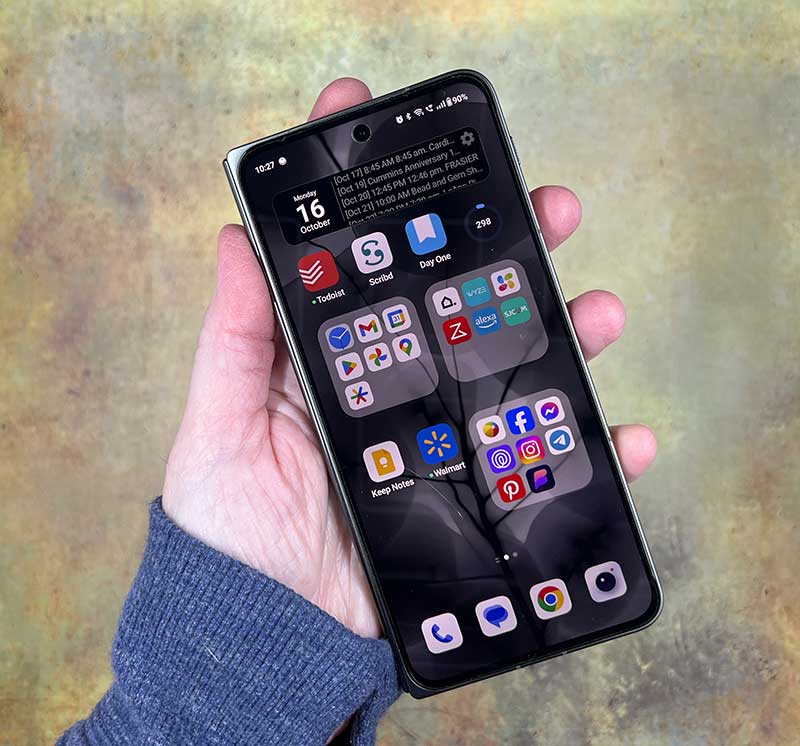
REVIEW – Having recently switched back to Android after a 3-year fling with the iPhone, I’ve been enjoying all that Android has to offer like its many hardware and customization options. However, the most exciting thing about Android for me right now is folding phones. I briefly tried a Samsung Galaxy Fold 5 and sent it back and I bought a Google Pixel Fold and while I like it, I don’t love it. But now I think I’ve found what I have been looking for and it’s the OnePlus Open. Let’s unfold it and take a closer look.
What is it?
The OnePlus Open is the latest Android smartphone from OnePlus and it is also their first folding phone.
What’s in the box?
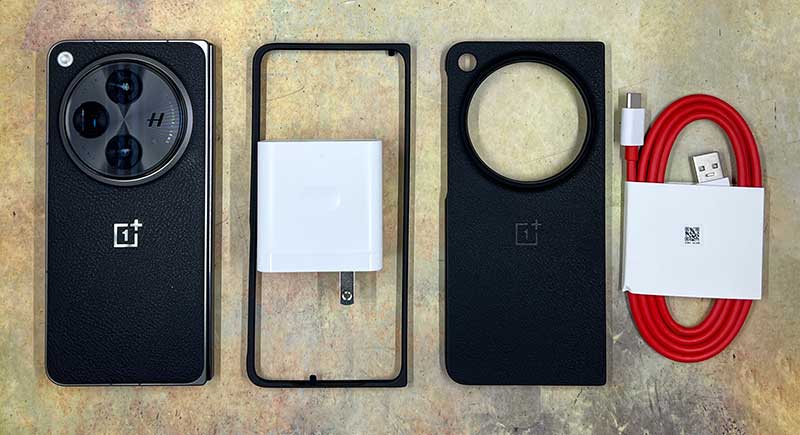
- OnePlus Open
- 80W SUPERVOOC Power adapter
- Protective cover
- USB-A to USB-C cable
- SIM tool
- Quick start guide
Specifications
Click to expand OnePlus Open hardware specs
Operating System: OxygenOS 13.2 based on Android™ 13
CPU: Qualcomm® Snapdragon™ 8 Gen 2
5G Chipset: X70
GPU: Adreno 740
RAM: 16GB LPDDR5X with RAM-Vita
RAM Expansion: 4/8/12GB
Storage: 512GB UFS 4.0
Display Size (Primary): 7.82 inches (Measured diagonally from corner to corner)
Display Resolution: 2440 * 2268 (2K) pixels 426 ppi
Display Aspect Ratio: 1.0758:1
Display Type: 1-120 Hz dynamic
Panel Type: Flexi-Fluid AMOLED with LTPO 3.0
Touch Response Rate: Up to 240 Hz, Support sRGB, DCI-P3, 10-bit Color Depth
Display Cover Glass: Ultra Thin Glass
Display Size (Secondary): 6.31 inches (Measured diagonally from corner to corner)
Display Resolution: 2484 * 1116 (2K) pixels 431 ppi
Display Aspect Ratio: 20:09
Display Refresh Rate: 10-120 Hz dynamic
Panel Type: Flexi-Fluid AMOLED with LTPO 3.0
Touch Response Rate: Up to 240 Hz, Support sRGB, DCI-P3, 10-bit Color Depth
Display Cover Glass: Ceramic Guard
Battery: 4805 mAh (Dual-cell 3295+1510 mAh), 67W SUPERVOOC Charging
Main Camera Sensor: Sony LYT-T808 “Pixel Stacked” CMOS
Sensor Size: 1/1.43″
Megapixels: 48
Pixel Size: 1.12µm
Focal Length: 24mm equivalent
Aperture: ƒ/1.7
Field of View: 85º
Telephoto Camera Sensor: Sony LYT-T808 “Pixel Stacked” CMOS
Sensor Size: 1/2″
Megapixels: 64
Pixel Size: 0.7µm
Focal Length: 70mm equivalent
Aperture: ƒ/2.6
Field of View: 33.4º
Ultra-wide Camera Sensor: Sony IMX581
Sensor Size: 1/2″
Megapixels: 48
Pixel Size: 0.8µm
Focal Length: 14mm equivalent
Aperture: ƒ/2.2
Field of View: 114º
Front Camera Primary:
Sensor Size: 1/4″
Megapixels: 20
Pixel Size: 0.7µm
Focal Length: 20mm equivalent
Aperture: ƒ/2.2
Field of View: 91º
Front Camera Secondary:
Sensor Size: 1/3.14″
Megapixels: 32
Pixel Size: 0.7µm
Focal Length: 22mm equivalent
Aperture: ƒ/2.4
Field of View: 88.5º
Dimensions Folded: 153.4 mm x 73.3 mm, Thickness: 11.9 mm
Dimensions Unfolded: 153.4 mm 143.1 mm, Thickness: 5.9 mm
Weight: 239g
Design and features
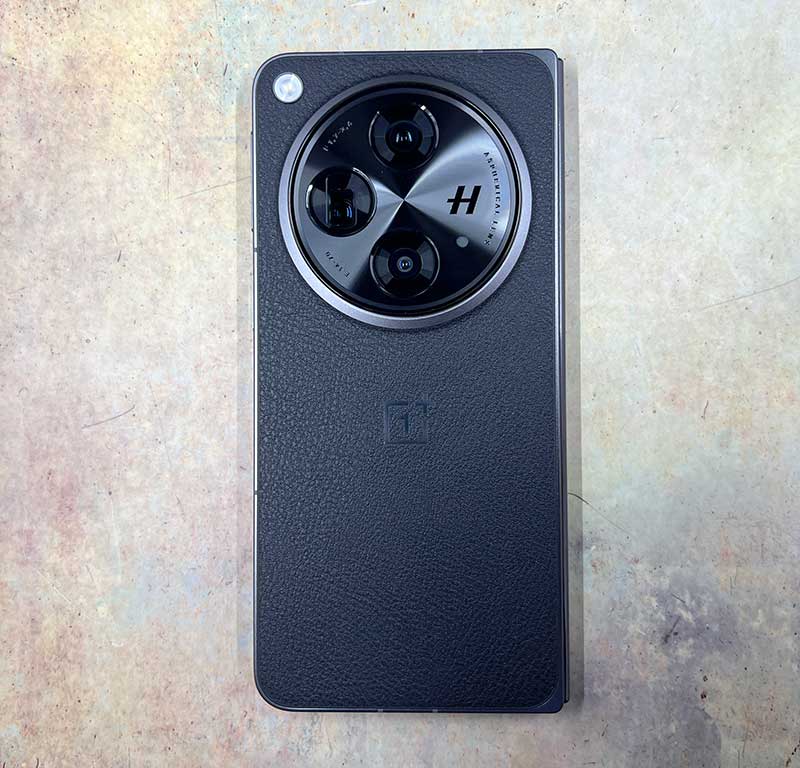
The OnePlus Open comes in 2 colorways. There’s an Emerald Dusk with a matte-frosted green glass back and there’s the Voyager Black which as you can see is the one that was sent to me. I feel lucky that this is the one that I received because it looks and feels amazing with the vegan leather back that reminds me of a vintage camera. The only branding is the OnePlus logo in the center. The logo in the image above makes it look like it’s stamped into the “leather”, but the logo is really a shiny embossed/stamp.
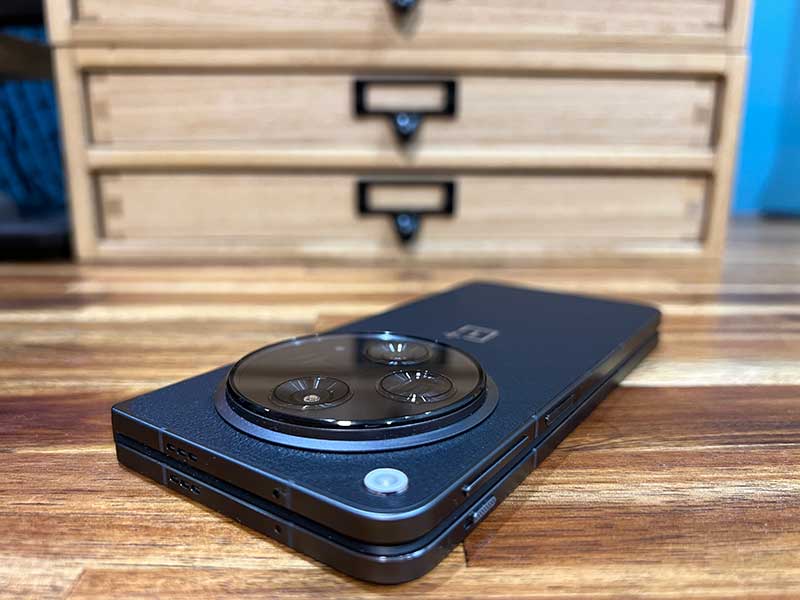
Of course, you can’t not notice the large 3 lens raised camera module up top with the separate flash bump in the top left corner. I’ll have more to say about the camera and its capabilities later in the review, but while it looks very large, I am happy to say that it doesn’t get in the way. I tend to use it as a makeshift “handle” to pull the phone out of my pocket.
Let’s take a tour around the phone. Starting at the top and continuing clockwise around the phone…
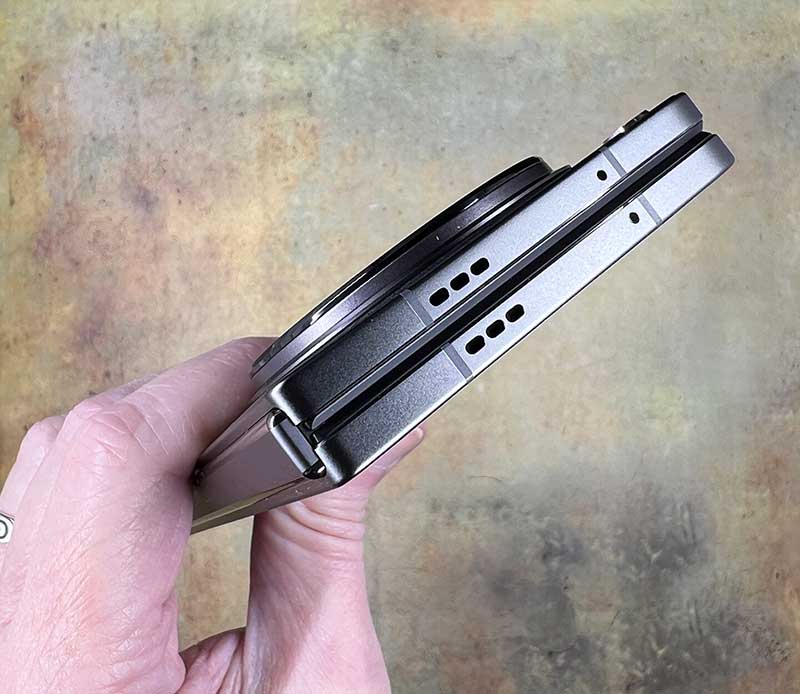
The top edge of the OnePlus Open gives the first look at the perfect fold of this phone. There’s absolutely no gap whatsoever. With the Google Pixel Fold, you can see daylight between the folded screen, but not so with the OnePlus Open. You can see the antenna lines, as well as a speaker and microphone on both halves.
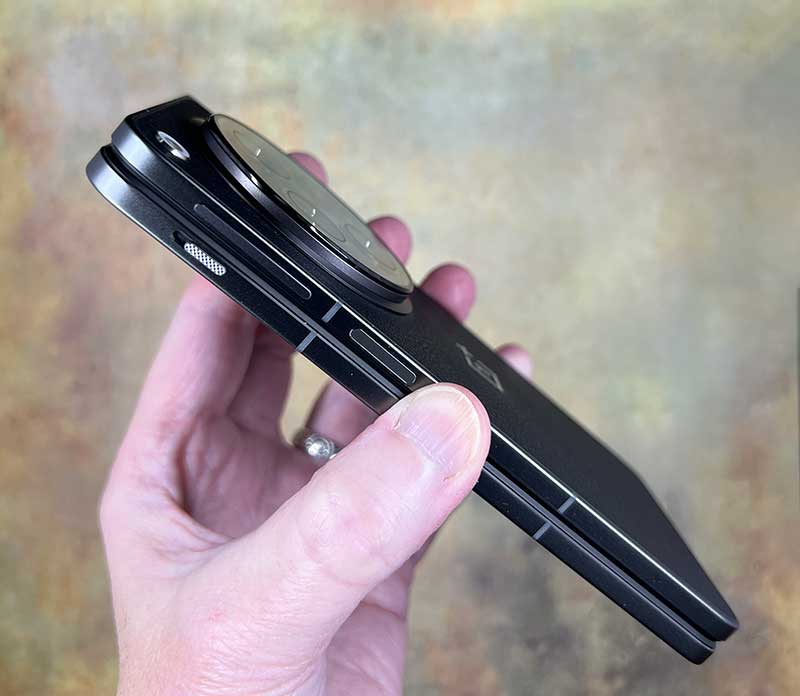
On the right edge of the phone, you’ll find a long volume rocker button, a power switch/fingerprint sensor, and a manual mute switch. Check out those flat edges with the brushed finish. The OnePlus Open always looks great with no icky smudges or fingerprints like I have on the Google Pixel Fold.
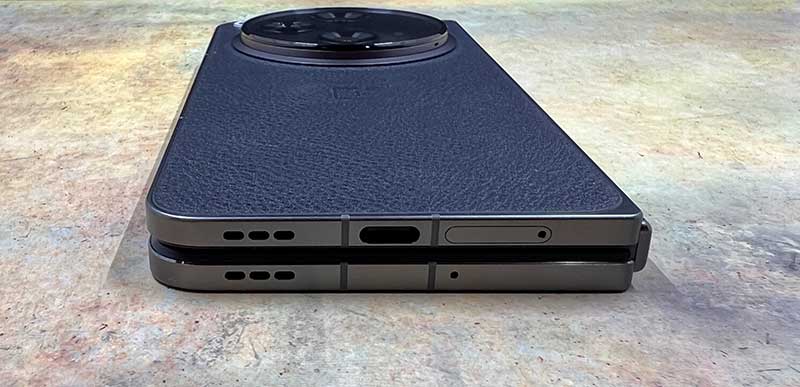
The bottom edge of the OnePlus Open has two more speakers, a microphone, a SIM card tray, and a USB-C port.
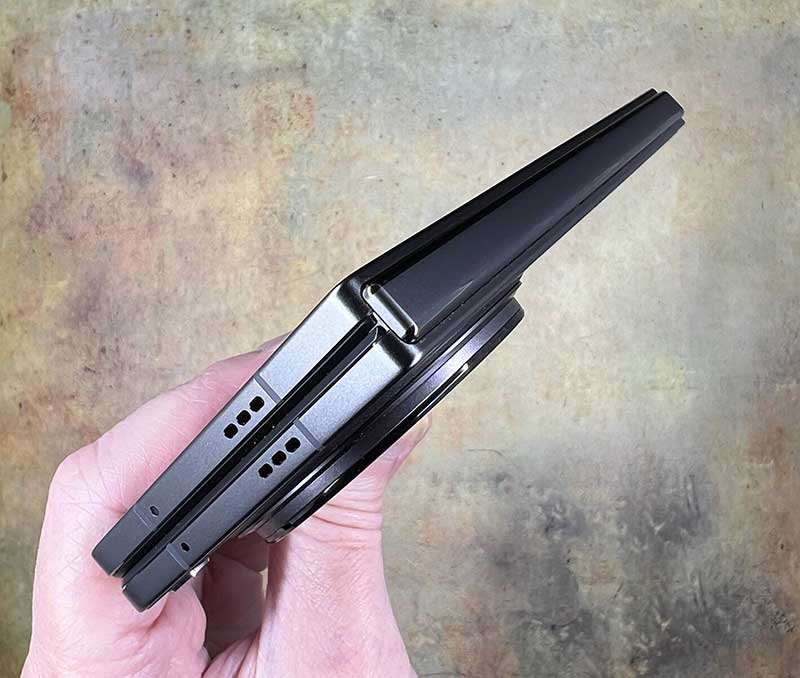
Here’s a shot of the hinge which OnePlus has named the Flexion Hinge. It continues with the flat brushed design which I really like because everything is well sealed when the phone is in this folded format. You don’t get nearly as much dust on the unfolded display as you might with other foldables. What sets the hinge on the OnePlus Open apart from other folding phone hinges? According to OnePlus…
Flexion Hinge: The hinge itself is built around a single-spine architecture, allowing for more efficient integration between components and a sturdier structure overall compared to conventional three-part spine that’s utilized on most folding competition today. Thanks to that, OnePlus was able to reduce the overall number of parts required to just 69 (vs the conventional 100+) components for the hinge, without affecting quality. This drastically reduces weight of the hinge and, in turn, overall weight of the device.
Before I go any further, I have to say that this phone is lightweight compared to what I expected. The Google Pixel Fold felt like a little brick and the OnePlus Open feels lighter than my iPhone 13 Pro Max. It always feels like I have a regular phone in my hand or pocket, which is a good thing.
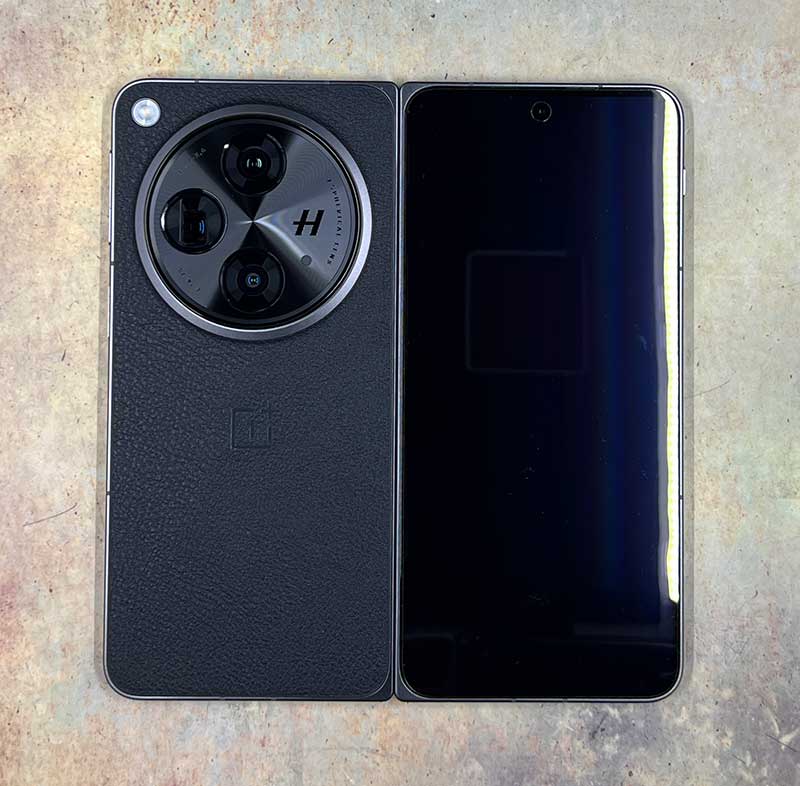
When fully opened, the front and back halves of OnePlus Open rest edge to edge which I think looks great.
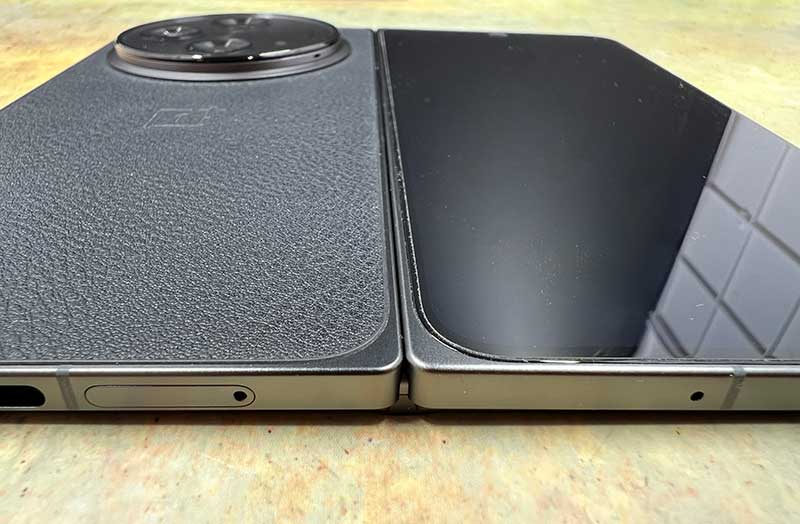
Here is a closer look at the opened display that also allows you to see vegan leather covering on the back of the Voyager Black colorway. You will also notice that the front-facing screen has a pre-installed screen protector.
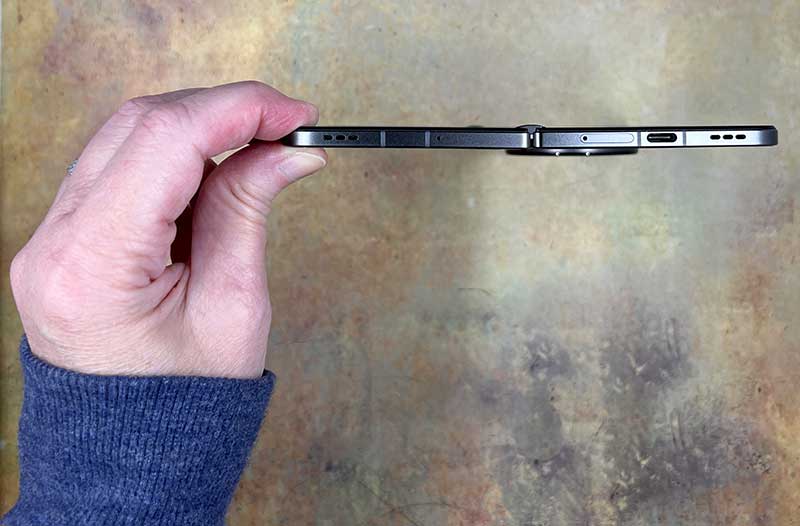
Check out that wonderfully thin goodness!
The OnePlus Open’s displays
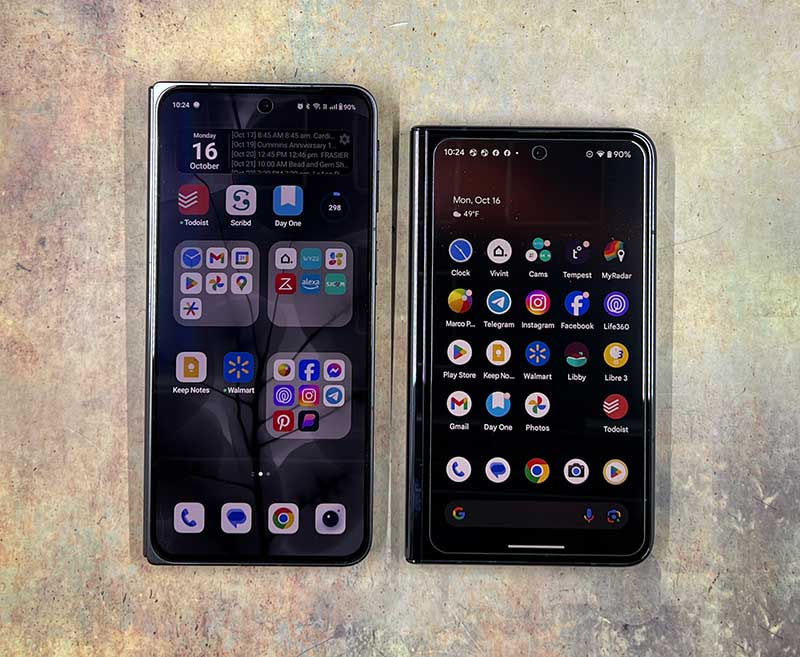
I’m going to compare the OnePlus Open’s displays to the Google Pixel Fold’s displays because that’s the only foldable that I have the most experience with. After a very brief time with a Samsung Galaxy Fold, I found the Pixel Fold’s folded format to be much easier and more comfortable to use compared to the Galaxy Fold’s ultra-narrow display but the Pixel felt so heavy. Then I received the OnePlus Open and I was suddenly Goldilocks because it felt just right both in weight and size/form factor.
As already mentioned, when the OnePlus Open is folded, it feels like you’re holding a regular non-folding phone. Yes, it’s thicker than a normal phone, but the weight and form factor feel pretty much perfect in my hand.
The outside display is vibrant, bright, and clear and I was happy to see that OnePlus includes a pre-installed screen protector on the wonderfully flat display.
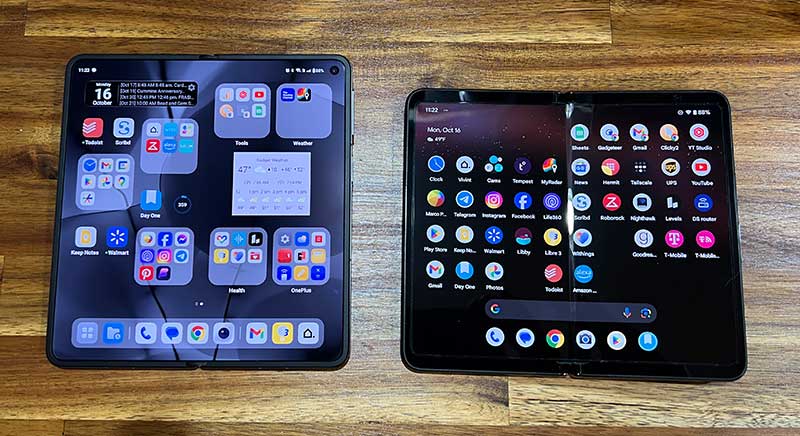
When opened, I liked the portrait layout of the OnePlus Open a bit more than the landscape layout of the Pixel Fold. I realize that this is a personal preference though.
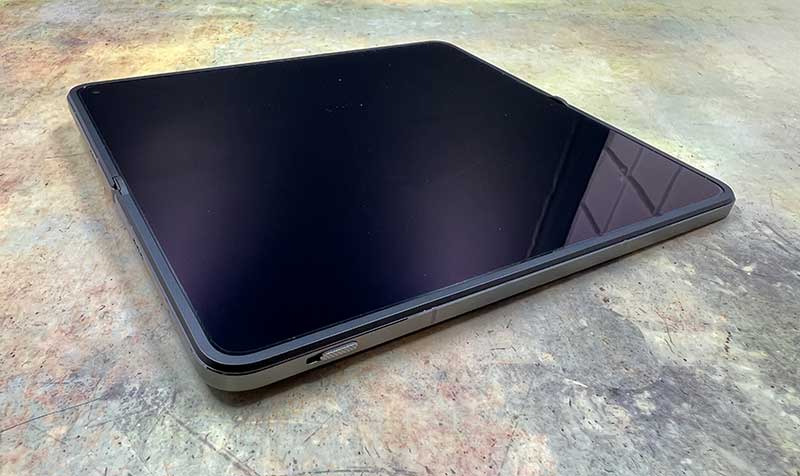
I like the narrow uniform bezels. But where’s the crease?
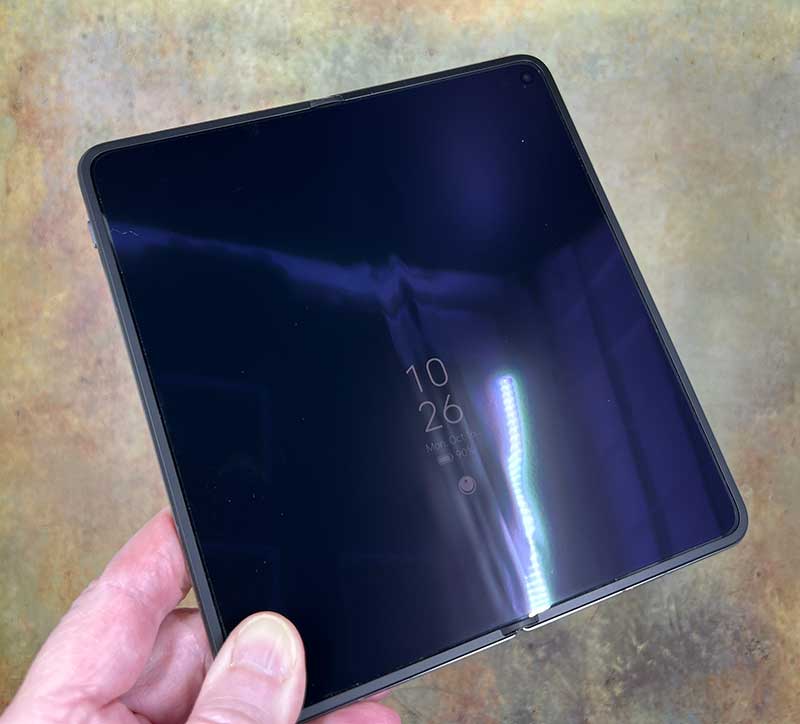
Don’t get your hopes up, because the crease is definitely there. But I will say that the crease on the OnePlus Open is the least noticeable crease of any foldable that I’ve tried so far which includes the Google Pixel Fold, Samsung Galaxy Fold 5, and Motorola Razr+. The “valley” in the middle is shallow so it’s subtle when you’re using your finger to swipe the screen. The opened screen really feels flat and smooth.
OnePlus has test-folded the Open more than 1,000,000 times and claims that it is good for way more than 10 years at more than 100 folds per day!
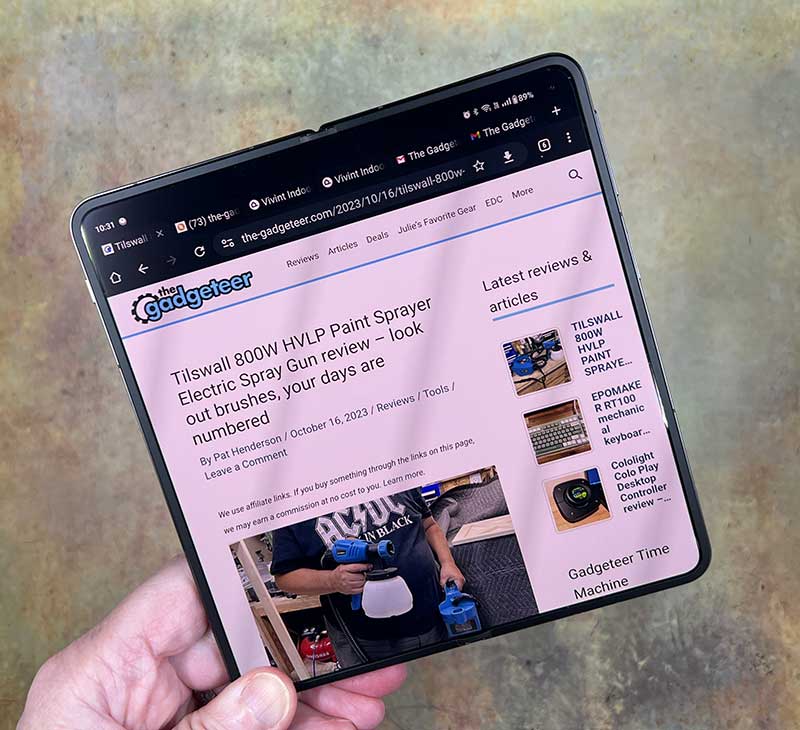
For me, the crease disappears when I’m using the OnePlus Open in the unfolded format.
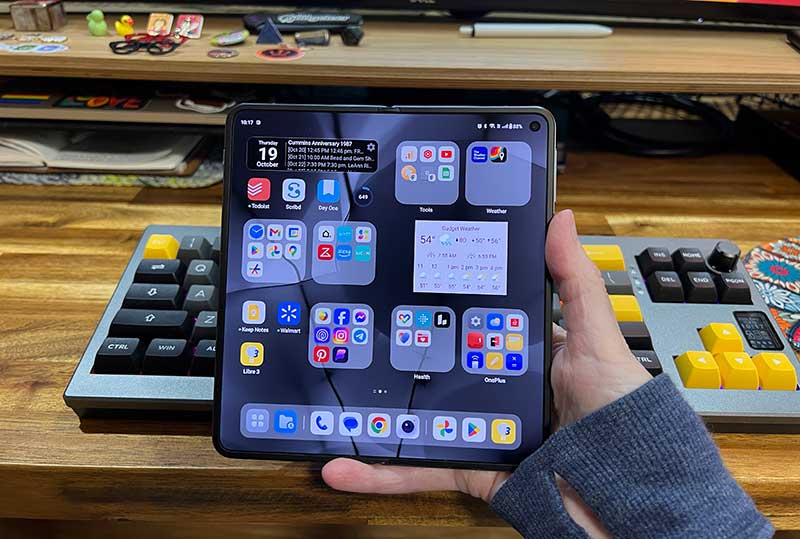
The inside display of the OnePlus Open isn’t as shiny and reflective as the Google Pixel Fold, so it’s just more comfortable to use for my eyes. I also find that the phone is more comfortable to hold in the open position compared to the Pixel because it feels more balanced in hand.
User interface and apps
The operating system that OnePlus uses for their phones is called OxygenOS. The current version of OxygenOS on the OnePlus Open is based on Android v13. It’s Android with an extra layer of features on top similar to how Samsung does it with their One UI. So, OxygenOS feels like stock Android but with some sauce.
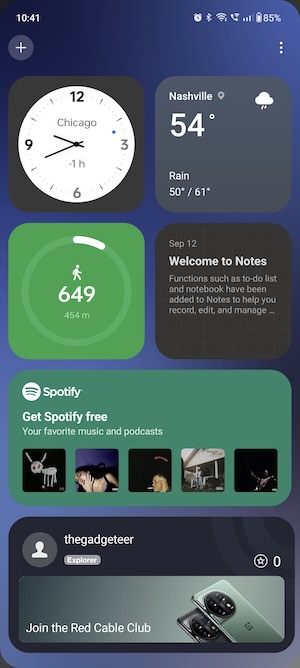
The OnePlus Open still has the Shelf screen like the OnePlus 11 that I reviewed a couple of months ago. The Shelf screen is accessed by pulling down from the center of the home screen. This screen can be customized with a selection of widgets. If you don’t like it, you can deactivate the Shelf feature in favor of the notification list.
One of my favorite features of OnePlus phones is the side drawer that you can slide open to quickly access your favorite apps without swiping through multiple home screens or opening folders.
I know that you can have multiple apps open on the unfolded display which I’ll get to next, but you can also have 2 apps open at the same time on the folded display. In the image above on the left, I have messages open at the bottom, and Marco Polo open on the top. You can also adjust the size of these 2 apps if you don’t want to sacrifice what you see but also want immediate access to the other app. I show this with the image above on the right. Again, we have messages and Marco Polo, but now Marco Polo is just a sliver at the top. When you want to flip to it, you just click the button in the right corner.
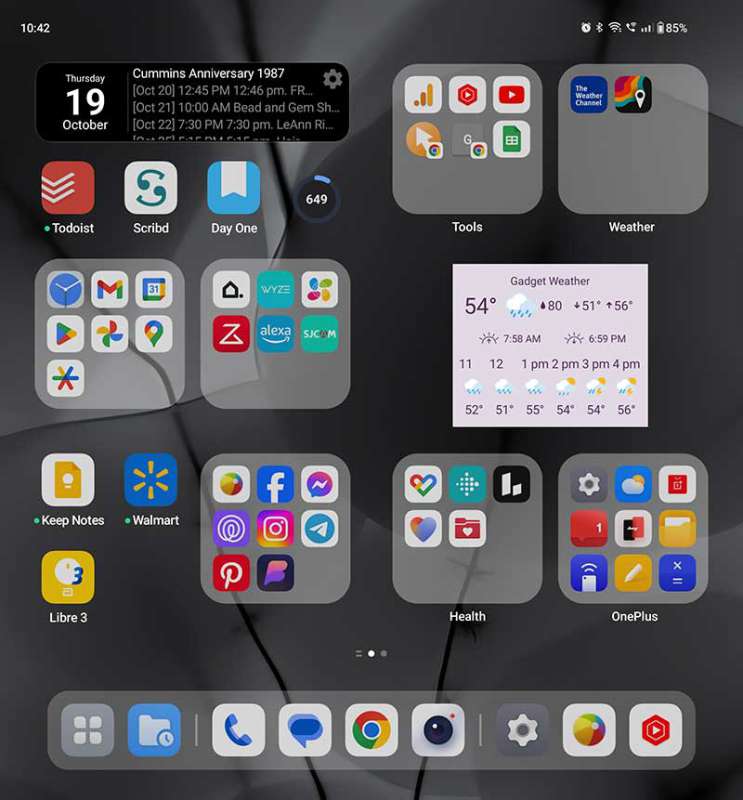
When the OnePlus Open is unfolded, you will see the first 2 home screens all on the unfolded display. Of course, you can swipe to the next home screen to the right. You’ll also see the taskbar at the bottom which you can hide when an app is open by tapping and holding.
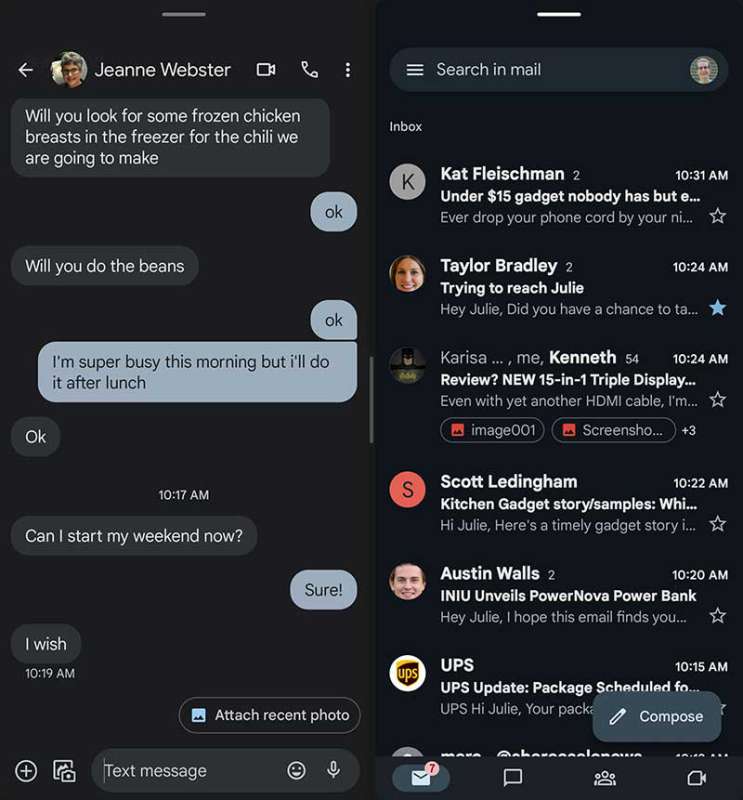
Two apps side by side allow for a good user experience. But you can open one more app in one of two ways.
You can have a third app as a floating window that you can then send to the side for quick access. So in the images above, I have Facebook and Gmail with my Freestyle Libre CGM (blood glucose sensor) app floating on top. If I want quick access to see what my blood sugar is, I can send it to the side which is that small white tab on the right side in the image above on the right.
The other ways you can quickly access a third application on the unfolded display can be seen above. The third app is on the edge of the display where you can tap on the narrow app to slide it over and then the other side will narrow.

Or you can use a 4 finger pinch to show all 3 apps on the screen.
What does the OnePlus Open look like with a full screen video playing?
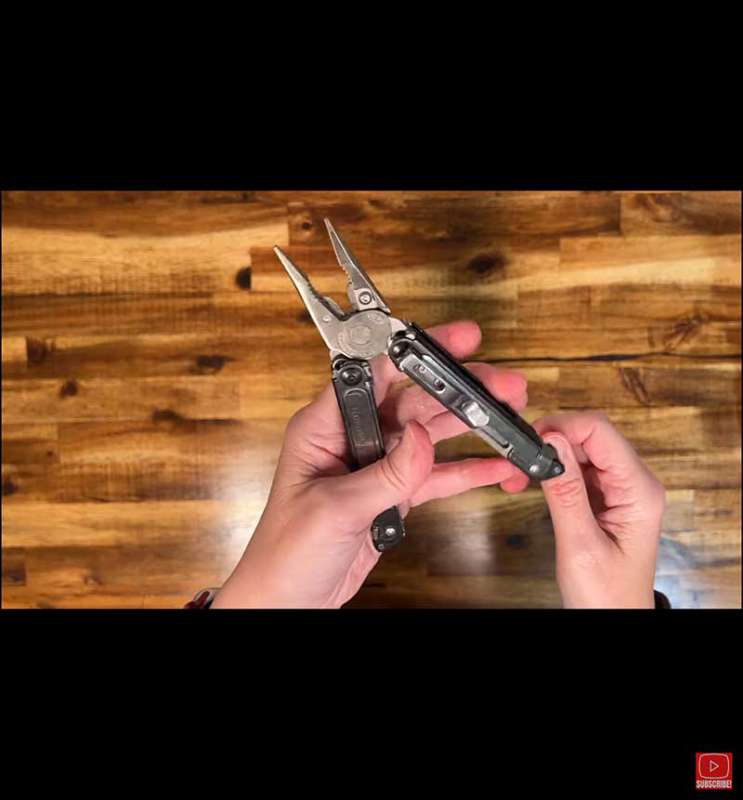
The phone wouldn’t let me take a screenshot of a Netflix movie, but here’s a screenshot of one of my videos on my YouTube channel set to full screen. Yes, you have black bars above and below the screen no matter how you rotate the screen… That may bother you, but it doesn’t for me.
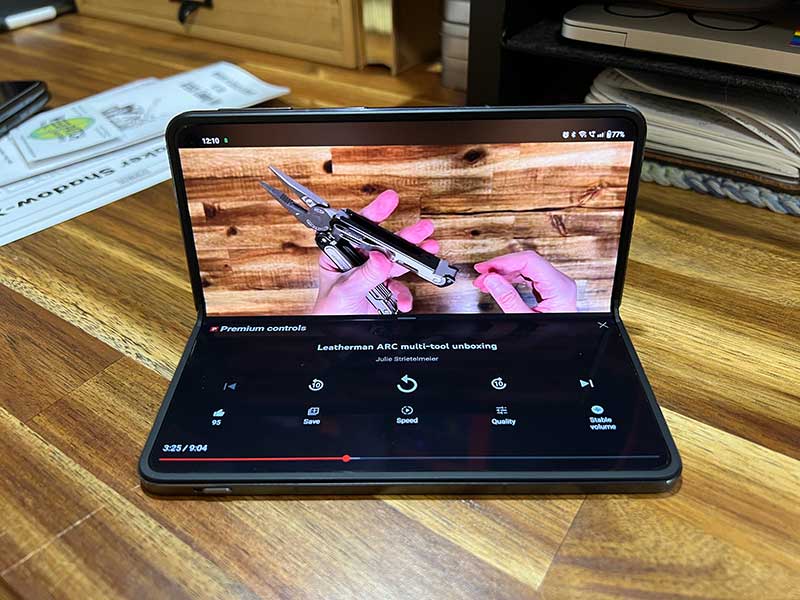
If you fold the phone to watch the video in the format above, you will have the video in the top screen and the controls below it.
Honestly, the OnePlus Open has a lot of features that let you customize how you can use it. I personally don’t use more than 2 apps at a time and most of the time, I’m only using 1 app. There are gestures and customizations that you can do, but there is a small learning curve.
Camera
Like most people these days, my phone is also my camera, and for me, that’s important because I use my phone for my review product shots and even videos like my Gadgeteer Podcast. Check out the gallery of pictures below that I took with this phone. The images have not been edited and you can click to view them in full size.
Selfies with the front-facing camera.
Close-ups
Zooming
Zooming part 2
A variety of pictures from a lovely fall day in Nashville, Indiana which is only about 7 miles from my house.
I found the colors to be true to life and have been happy with the photos that this phone captures.
Fingerprint sensor and face unlock
I prefer to use face unlock because I find it quicker and easier and fingerprint reader sensors almost never work consistently for me. With the OnePlus Open, the face unlock works great as long as I’m not in the dark. Unlike OnePlus 11 which had the fingerprint sensor in the display, the Open’s fingerprint sensor is in the power button and… it doesn’t work for me very well. Ugh. Even if I reprogram my prints often, it only works for a few hours before it starts requiring many many presses before it recognizes my print. I think it’s because my hands/fingers are drier than most people… That’s my theory.
Making and receiving calls with the OnePlus Open
It’s funny that making and receiving calls is the least used function that I use on a smartphone these days, but I tested this feature and had no issues with either side of the calls that I placed or received. Volume levels and clarity on both sides of calls were just fine.
Overall performance and battery life
I have no complaints about the performance of this phone. All my favorite apps launched quickly, and scrolling through webpages and apps felt smooth with no lags or stutters. And it doesn’t break a sweat like the Google Pixel Fold which gets warm with regular use. The OnePlus Open is cool as can be all the time.
When it comes to battery life, I had no problems getting through a full day using the OnePlus Open for all of my normal tasks (email, reading ebooks, watching YouTube videos, Marco Polo sessions, Instagram scrolling, etc). This was a breath of fresh air compared to my experience with my Google Pixel Fold which barely makes it through one day of normal use before needing to be topped off or put on the wireless charger next to my bed while I sleep.
Here’s a small example of the battery life that I have been enjoying. I took it off the charger at 6 AM with a 100% charge and ended the day with a 38% charge. The next morning it was at 32% at 6 AM. Not bad after a day of shooting pictures for this review, dozens of Marco Polo video sessions, emails, surfing, etc.
I still continue to be disappointed with OnePlus because they don’t have a wireless charging feature in their phones. But I can’t be too bummed because the battery life on this phone is so good and it charges crazy fast using the included 80W SUPERVOOC charger. It can charge the 4805Ah battery from 1% to 100% in about 42 minutes which is insane! I still miss wireless charging though.
OS and security updates
OnePlus promises 4 years of Android OS updates and 5 years of bi-monthly security updates.
What I like
- Lightweight and thin design
- Voyager Black has a cool “leather” back cover that adds grip
- Love the camera, especially the macro capabilities
- Great battery life
- Runs cool
What I’d change
- Add wireless charging, please!
- Add a DEX-like desktop experience when plugged into a monitor
Final thoughts
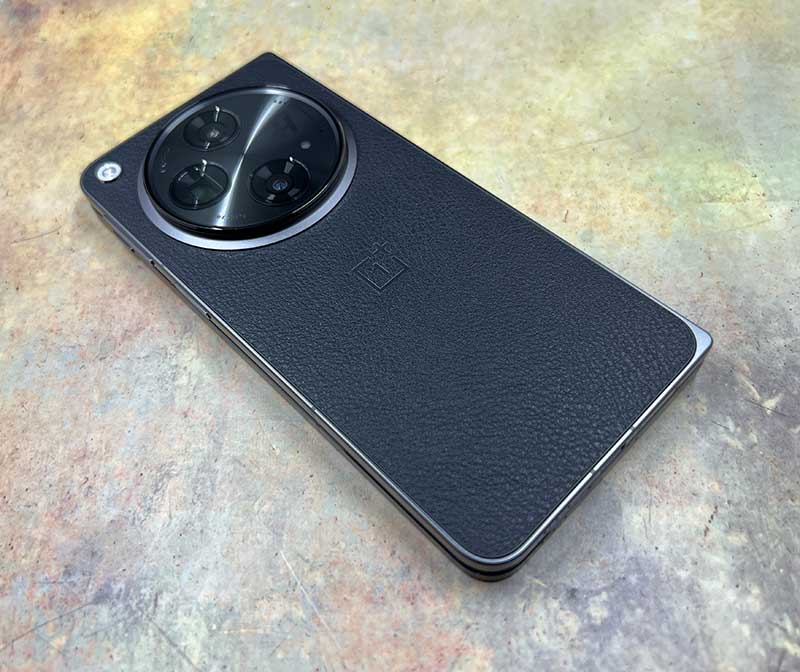
It has taken me a while to get on the folding phone bandwagon, but now that I have, folding phones have brought a new sense of fun to my everyday phone use with the OnePlus Open leading the pack even after only using it for less than 2 weeks. The OnePlus Open has a lot going for it from look and style to great battery life, performance, and a really nice camera. There really isn’t much that this folding phone lacks other than maybe a DEX-like experience and wireless charging. But as it stands right now, this is my current favorite Android folding phone and I highly recommend it. Now, who wants to buy my Google Pixel Fold (Yes, I’m being serious)?
Price: $1699.99 (get $200 – $1000 off with a trade-in through OnePlus.com of ANY phone in ANY condition)
Where to buy: OnePlus and Amazon
Source: The sample for this review was provided by OnePlus.
"Smartphone" - Google News
October 19, 2023 at 10:37PM
https://ift.tt/VNJMc4d
OnePlus Open review - my new favorite folding Android smartphone! - The Gadgeteer
"Smartphone" - Google News
https://ift.tt/kDcQhnb
https://ift.tt/Y01VZ6c
Bagikan Berita Ini
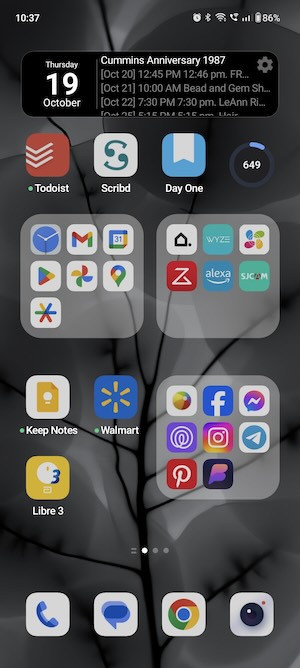
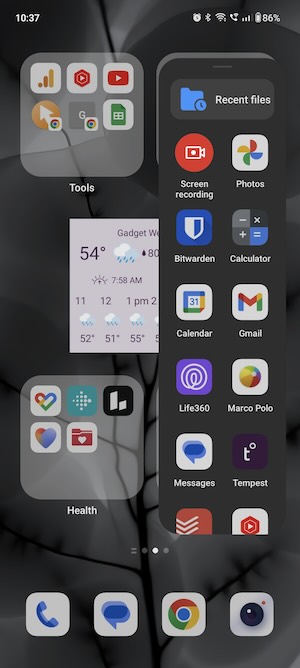
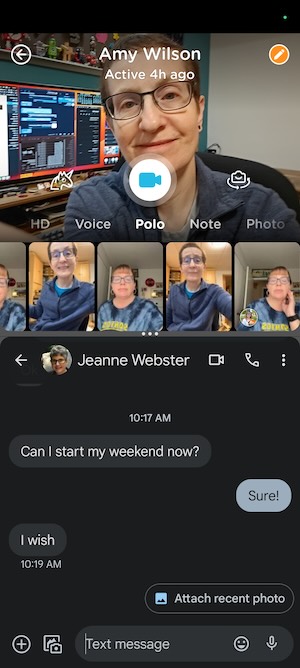
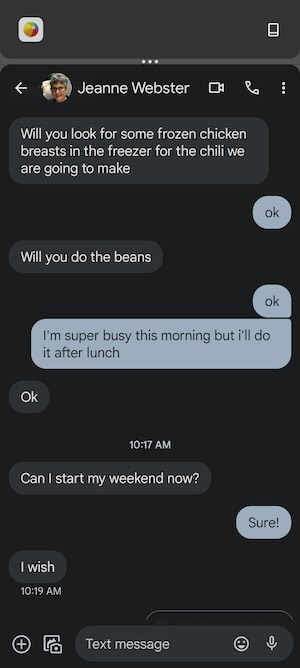
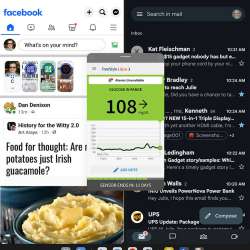
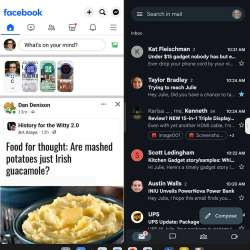
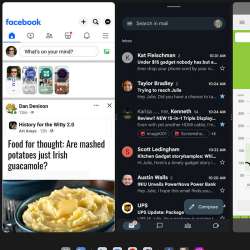
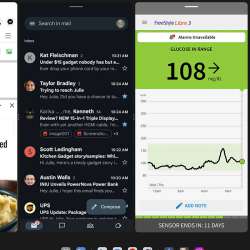

















0 Response to "OnePlus Open review - my new favorite folding Android smartphone! - The Gadgeteer"
Post a Comment